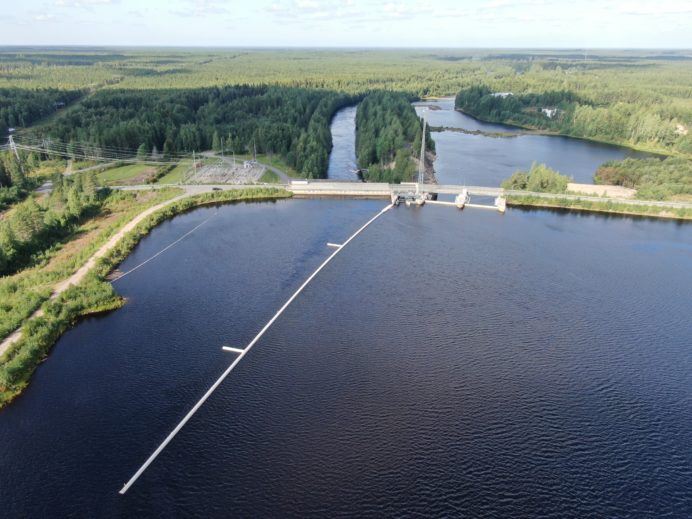
In June, Natural Resources Institute Finland (Luke) investigates the functionality of a downstream migration route for salmon fry near the Haapakoski hydropower plant on the Iijoki river. The monitoring area also covers the area upstream of the Haapakoski rapids, i.e. the area above the Pahkakoski hydropower plant, and with less frequent monitoring points, the lower route down to the mouth of the river. The data on salmon fry behaviour will support future planning of downstream migration routes in Iijoki and other large harnessed rivers.
A downstream migration route for salmon and sea trout fry past a hydroelectric dam was completed in Haapakoski rapids on the Iijoki river last summer. The route consists of a 180 m steel guiding fence installed in the top channel and a downstream migration route built in a former log driving channel. The downstream migration route is the first solution for fish migrating downstream from a hydroelectric dam in a large river in Finland.
“The aim of the downstream migration route is to get the migrating fry quickly and safely below the power plant. In many cases, dam structures slow down or even cut off the journey of migrating fry to the sea. Migrating fry may stop above the hydroelectric dam, making them easy prey for predatory fish, or they may try to pass through the power plant’s turbines, which can cause fish mortality,” explains Riina Huusko, a researcher at Luke.
Luke monitors the behaviour of migrating salmon fry in the vicinity of the Haapakoski guiding fence and between the two uppermost power plants, Haapakoski and Pahkakoski, by means of acoustic fish tags placed in the abdominal cavity of fish. A total of 105 tagged salmon fry will be released above the Haapakoski power plant, and 180 directly into the constructed downstream migration route. Signal receivers will be placed around the guiding fence in the top channel at Haapakoski and above the Pahkakoski power plant. The monitoring will be continued up to the mouth of the river with individual receivers.
Results for the functionality of the route and the survival rate of fry are expected at the turn of the year
In 2020, before the completion of the actual downstream migration route, promising results were obtained for the functionality of the Haapakoski guiding fence. The majority of the fry swam in the desired direction, away from the current diverted to the turbines. This year’s monitoring effort focuses on the functionality of the guiding fence and the downstream migration route together.
There are no structures to facilitate the downstream migration of salmon fry at Pahkakoski yet. The situation is similar to that of Haapakoski in the spring of 2017 when the behaviour of salmon fry in the area was studied before the implementation of the downstream migration route. The monitoring results can now be compared to the various flow conditions, and the data can be used to support comprehensive planning of downstream migration routes on the Iijoki and other rivers of similar size.
The restoration of salmon stocks in harnessed rivers requires the restoration of the migration route both ways. Fry need to get to the sea from their feeding migration to the upper reaches of the river to mature, and in time, adult fish need to return from the sea to their breeding grounds upstream. Haapakoski is the topmost hydropower plant in the main channel of the Iijoki river, and Pahkakoski is the next plant downstream. The guiding fence and the downstream migration route were implemented by the Iijoki river migratory fish spearhead project and the Iijoki river migratory fish project coordinated by the Council of Oulu Region in 2020–2022.
The monitoring of the behaviour and survival rate of salmon fry in the river downstream of the migration route is part of the Lohi Iijokeen project managed by the Council of Oulu Region and Luke. The investigation of the functionality of the guiding fence at Haapakoski in Iijoki is part of the Sateenvarjo III research project coordinated by Luke and funded by Oulu Energy Ltd, Fortum Corporation, Kemijoki Oy, PVO-Vesivoima Oy, Vattenfall Oy, UPM Energy Ltd, Helen Ltd, Kolsin Voima Oy, the Environmental Research Pool of Finnish Energy, the Ministry of Agriculture and Forestry, and Luke. The Centres for Economic Development, Transport and the Environment for Lapland, North Ostrobothnia, North Savo and Southwest Finland are partners of the Sateenvarjo III project.
The Lohi Iijokeen project is funded by PVO-Vesivoima Oy, the migratory fish stock restoration project (NOUSU) of the Ministry of Agriculture and Forestry (granted by the Centre for Economic Development, Transport and the Environment for Lapland), the municipalities of Ii, Oulu, Pudasjärvi, Taivalkoski and Kuusamo, the Iijoki Fisheries Association, the Council of Oulu region, and Natural Resources Institute Finland. Metsähallitus and the Centre for Economic Development, Transport and the Environment for North Ostrobothnia also implement the project as part of their official duties.